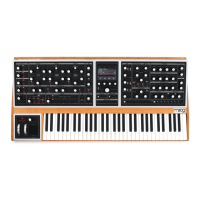81
ARPEGGIATOR (Continued)
SYNC (OFF, ON)
When SYNC is Off, the Arpeggiator is free to run at its own speed and clock rate. When SYNC is On, the
Arpeggiator and Master Clock are synchronized, and the Master Clock determines the Arpeggiator tempo.
NOTE: When SYNC is selected here, rotating the Arpeggiator RATE knob on the Front Panel will select
quantized clock divisions (see below) of the Master Clock.
CLOCK DIVISION (4, 2, 1, 1/2, 1/4, 1/8, 1/16, 1/32)
When sync’d, the Master Clock provides a tempo base; divisions of that Master Clock are used to set
the Arpeggiator speed. Changing the CLOCK DIVISION parameter species the timing in terms of
quarter-note beats.
CLOCK TIMING (STRAIGHT, DOTTED, TRIPLET)
When sync’d, Clock Timing provides a further modication of the step duration, allowing for a wider
selection of note timings relative to the Master Clock tempo.
STRAIGHT
The timing of each note is played as specied by the Clock Division.
DOTTED
The timing of each note is modied to play as a dotted note, or at 1.5 x the value specied by the
CLOCK DIVISION parameter.
TRIPLET
The timing of each note is modied to play as if it were one note in a triplet, or at 2/3rds of
the value specied by the CLOCK DIVISION parameter.
GATE LENGTH (1% to 100%)
Adjusting the GATE LENGTH parameter changes the duration of each arpeggiated note in the pattern.
Lower values will be more percussive and abrupt, higher values will be more owing and legato.
FOLLOW SWING (OFF, ON)
The Master Clock includes parameters related to adding swing to the beat. When sync’d to the Master Clock,
the Arpeggiator can either follow this swing information, or ignore it and play strictly to the BPM setting.
NOTE RESET (OFF, ON)
This parameter species how the timing of the Arpeggiator will behave when a new note is played on
the keyboard. When the NOTE RESET parameter is On, the Arpeggiator begins instantly, resetting the
downbeat timing of the current Clock Division to match the note as it is played. When the NOTE RESET
parameter is Off, the Arpeggiator will wait for the start of the next specied Clock Division before the
pattern begins.
PENDULUM MODE (ONCE, TWICE)
This PENDULUM MODE parameter is different that the Pendulum function of the Front Panel. Here,
the parameter species if the notes at the extreme ends of the Arpeggiator pattern are played once
before reversing direction, or twice – once for the last note on the way up, and again as the rst note
on the way down. This allows the Moog One arpeggiator to accurately mimic the behavior of different
Arpeggiators from different keyboards that have been popular over the years.
RANDOM MODE (NON-REPEATING, REPEATING)
This parameter species how the notes in a RANDOM pattern will be played. Choosing NON-
REPEATING prevents the same note from being played twice (or more times) in succession, so the
pattern is slightly less than random. By choosing REPEATING, no constraints are imposed on the
randomness of the pattern, and the same note may be played twice (or more) in a row.

